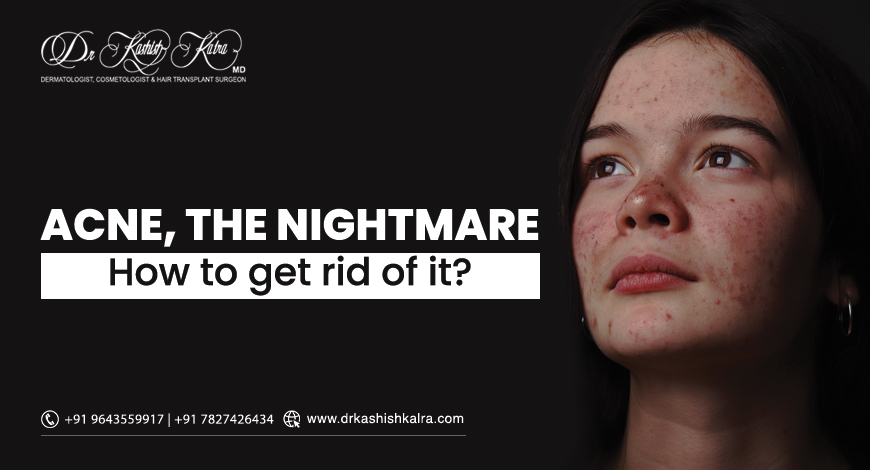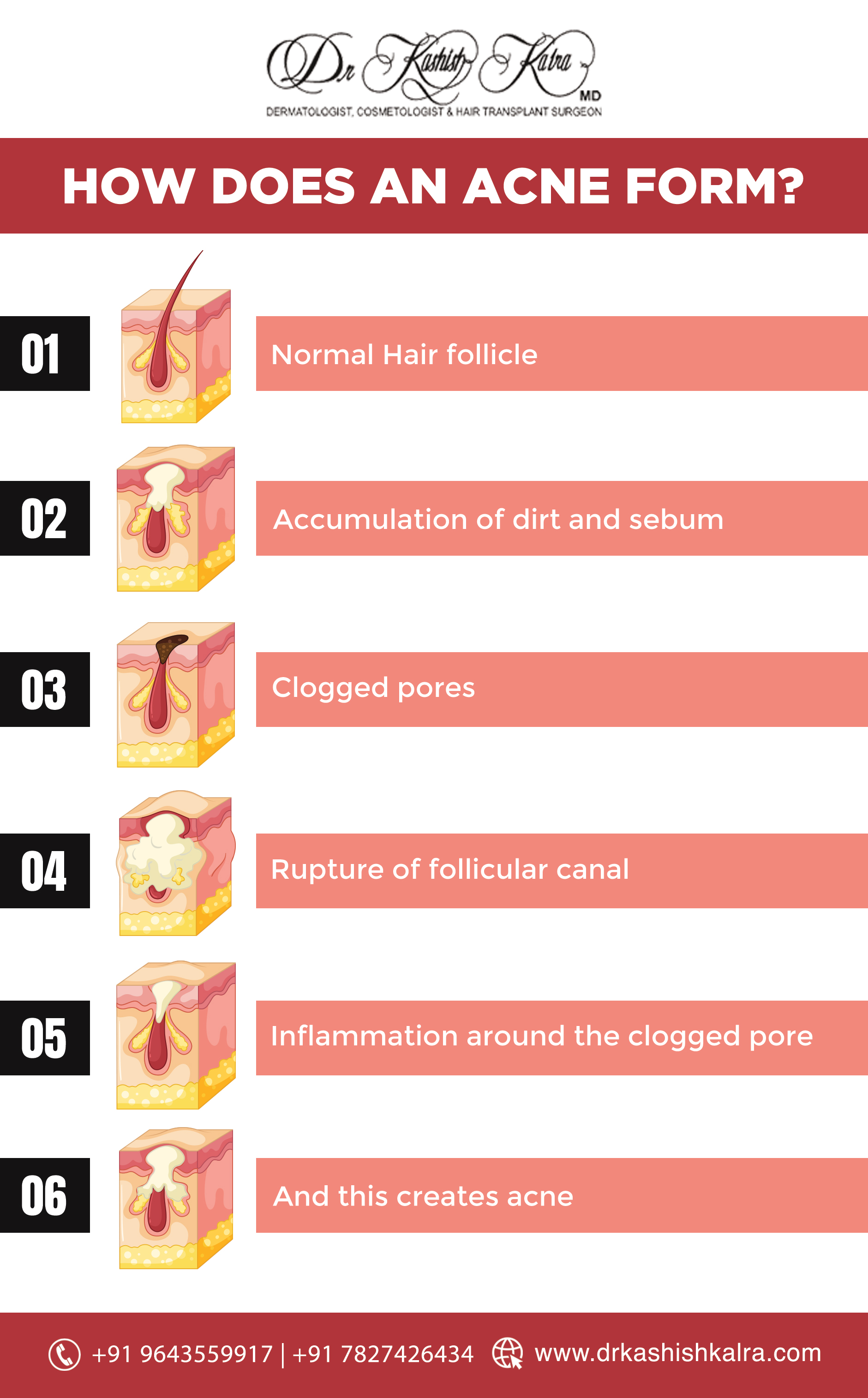
Different Types of Acne and Their Treatment
Acne treatment is one of the most popular searches on Google for a genuine reason. Acne that generally starts in puberty continues till adolescence and even adulthood affects approximately 9.4 percent of the global population. However, acne treatment at the earliest stage can go a long way to prevent and manage this skin condition.

Table Of Contents
Feel free to skip ahead if one topic catches your eye
- Science behind the formation of acne
- What are the different types of Acne?
- When to see a doctor?
- How are these treated?
1. Science behind the formation of acne
Acne (or acne vulgaris) is a multifactorial, chronic inflammatory disorder of the skin that affects more than 80 percent of the global population during some years of their life.
Acne occurs when the skin pores get blocked with dead skin, bacteria, or oil. Each skin pore is the opening to a follicle that is made of a sebaceous (oil) gland and hair. The oil gland releases sebum that keeps the skin soft and lubricated. However, acne occurs when dead skin cells accumulate in the pores, excess oil starts getting produced in the follicles, and bacteria gets built up in the pores.
2. What are the different types of Acne?
Acne can be classified into six types:
- Whiteheads: They are noninflammatory acne lesions that are generally not painful and don't cause swelling. Also known as comedones, whiteheads are whitish, small, or flesh-coloured bumps or spots that generally have a circular, white centre that is surrounded by a red halo. The skin surrounding a whitehead may look wrinkled or tight, especially if the whitehead is raised or large. They can be treated with over-the-counter gels, creams, toners, rinses, and moisturisers and people with whiteheads should ideally wash their face with soap and lukewarm water twice every day. Eating a balanced and healthy diet, cutting down on stress, and staying hydrated can help in managing whiteheads.
- Blackheads: Blackheads, also known as open comedones, are noninflammatory acne lesions that are black, small, or dark-coloured spots that can show as slightly raised bumps. They are generally not painful and don't cause swelling. The skin surrounding a blackhead generally appears normal, while the blackhead's centre region is usually darker in tone than the surrounding area. Blackheads are whiteheads that have widened and opened over time and gain a darker tone after the whitehead's contents were exposed to air. People with blackheads should try ways to reduce stress, stay hydrated, and wash their face with lukewarm water and soap two times every day. The use of over-the-counter creams, toners, rinses, moisturisers, and gels is recommended.
- Pustules (pimples): They are tender, larger bumps with a defined circular centre that is filled with yellowish or whitish pus, and the bump has a red or pink base. Generally, Pustules appear much larger and more inflamed whiteheads. The use of products including benzoyl peroxide and salicylic acid can prove useful to prevent bacteria and remove dead skin cells as well as other debris.
- Cysts: Cysts are inflammatory acne lesions (filled with pus) that are painful, very large, soft, white or red lumps situated deep in the human skin. Cysts are considered to be the most severe type of acne blemish and may cause scarring. You need to have a word with a skin specialist or dermatologist to treat cysts. Treatment options for cysts might include topical corticosteroids, antibiotics (doxycycline, amoxicillin, and tetracycline), systemic retinoids, oral contraceptives (when acne are hormonal-related), chemical peels, steroid injections, and photodynamic therapy to name a few.
- Nodules: Nodules are acne lesions that are inflamed, painful, and hard lumps located deep beneath the skin. They appear as deeper, larger papules with no visible head or centre. Nodules may result in severe skin complications like scarring or dark spots and develop when cells and tissues deep under the surface of the skin are damaged by clogged pores. Treatment for nodules might involve products and procedures (chemical peels, steroid injections, topical corticosteroids, systemic retinoids, and antibiotics) as recommended by a skin specialist or dermatologist.
- Papules: They can be described as bumps under the surface of the skin. Papules (inflammatory acne lesions) are raised, pink, tender, and solid. The skin around papules is generally red and slightly swollen. Papules are not characterised by a visible centre unlike whiteheads and the papule pores don't show up as widened, unlike blackheads. They develop when blackheads or whiteheads result in so much irritation that the surrounding skin gets damaged causing inflammation. Papules can be treated with over-the-counter medications. It is recommended to wash the affected area with soap and cool water every day using a clean and gentle face cloth or clean hands.
3. When to see a doctor?
If you are experiencing minor-to-moderate acne, you may try home remedies and over-the-counter medications for 4-8 weeks. However, you should seek immediate intervention from a doctor or dermatologist if blackheads, papules, whiteheads, or pustules are severe, very large, painful, and don't respond to over-the-counter medications. Medical advice is also recommended if they are bleeding, releasing a lot of pus, causing severe emotional distress, or have started covering a significant portion of the body or face.
4. How are these treated?
If over-the-counter medications and home remedies have failed to treat acne or if you are experiencing severe acne and its symptoms, then a visit to the dermatologist for acne treatment becomes mandatory. You may be advised to undergo laser treatment. The dermatologist may recommend Light therapy, chemical peel, soft tissue fillers, dermabrasion, needling or rolling, or other energy-based resources in combination with laser treatment for acne.
Take Away
Acne skin treatment is a complex and sophisticated procedure and therefore you should only trust an experienced and qualified dermatologist. Laser treatment for acne can be an excellent choice for you as it emphasises on top skin layers to break up the scar tissue while encouraging healthy, new skin cells to grow and then replace the scar tissue. This skin rejuvenation procedure is ideal for smoothing textured deformities and balancing skin tone.
Whether you're proud of the skin you are presently in or considering laser treatment for acne, you need to gain as much information as possible such as the types of acne, acne skin treatment procedures, etc. to make a confident and informed decision. Know more about the best ways and treatment to care for your skin by contacting Dr Kashish Kalra's Clinic, the best dermatologist in Delhi for acne, to receive the best acne treatment in Delhi. The clinic has teams of experienced and qualified dermatologists, skin specialists, and medical professionals and is equipped with state-of-the-art facilities so that you are always assured of the best skincare experiences. Call Dr Kashish Kalra's Clinic now!
References
1^ Myth: Biotin Prevents Hair Loss Health Healthline | March, 2,2021
2^ Myth: Wearing Hats Make you Bald WebMD | March, 2,2021
3^ Myth: Too Much Testosterone Causes Hair Loss Healthline | March, 2,2021
4^ Myth: Shampoo Makes you Lose Hair Phillip Kingsley | March, 2,2021
5^ Myth: You Inherit Hair Loss from your Maternal Side NCBI | March, 2,2021
6^ Myth: Masturbation Makes you Bald Medical News Today | March, 2,2021
7^ Myth: Vitamins Can Stop Hair Loss NCBI | March, 2,2021
8^ Myth: Only Older People Suffer from Baldness Young Men’s Health Site | March, 2,2021
9^ Myth: Stress Causes Hair Loss Keeps | March, 2,2021

